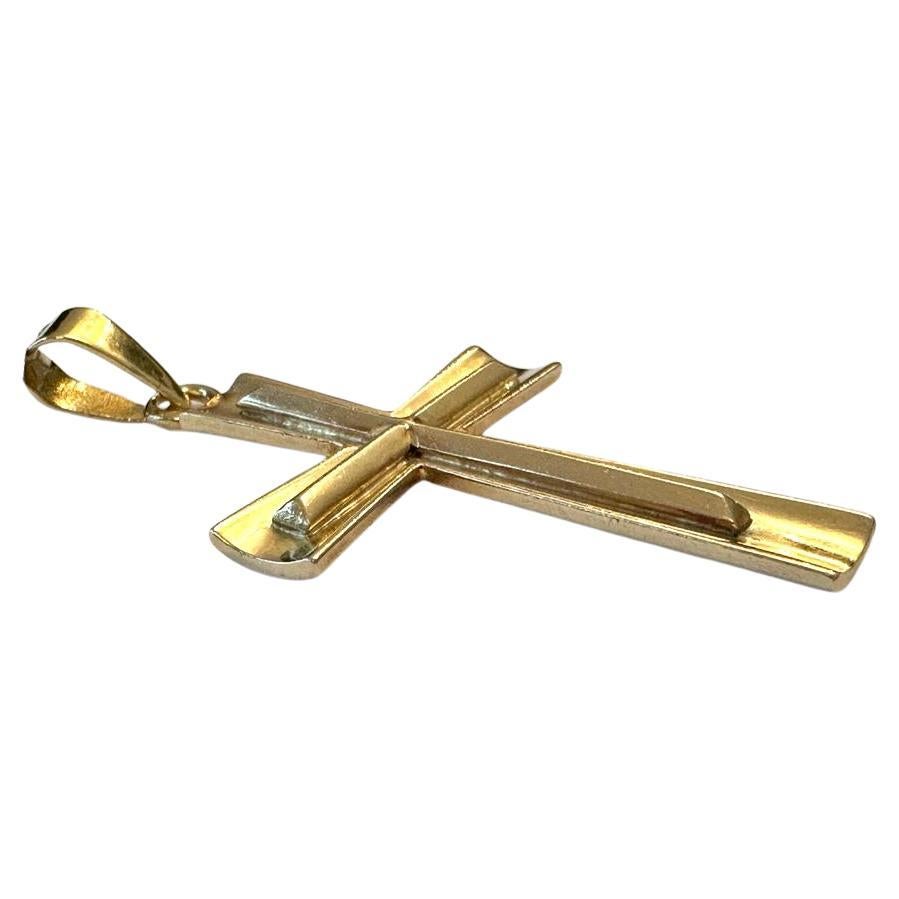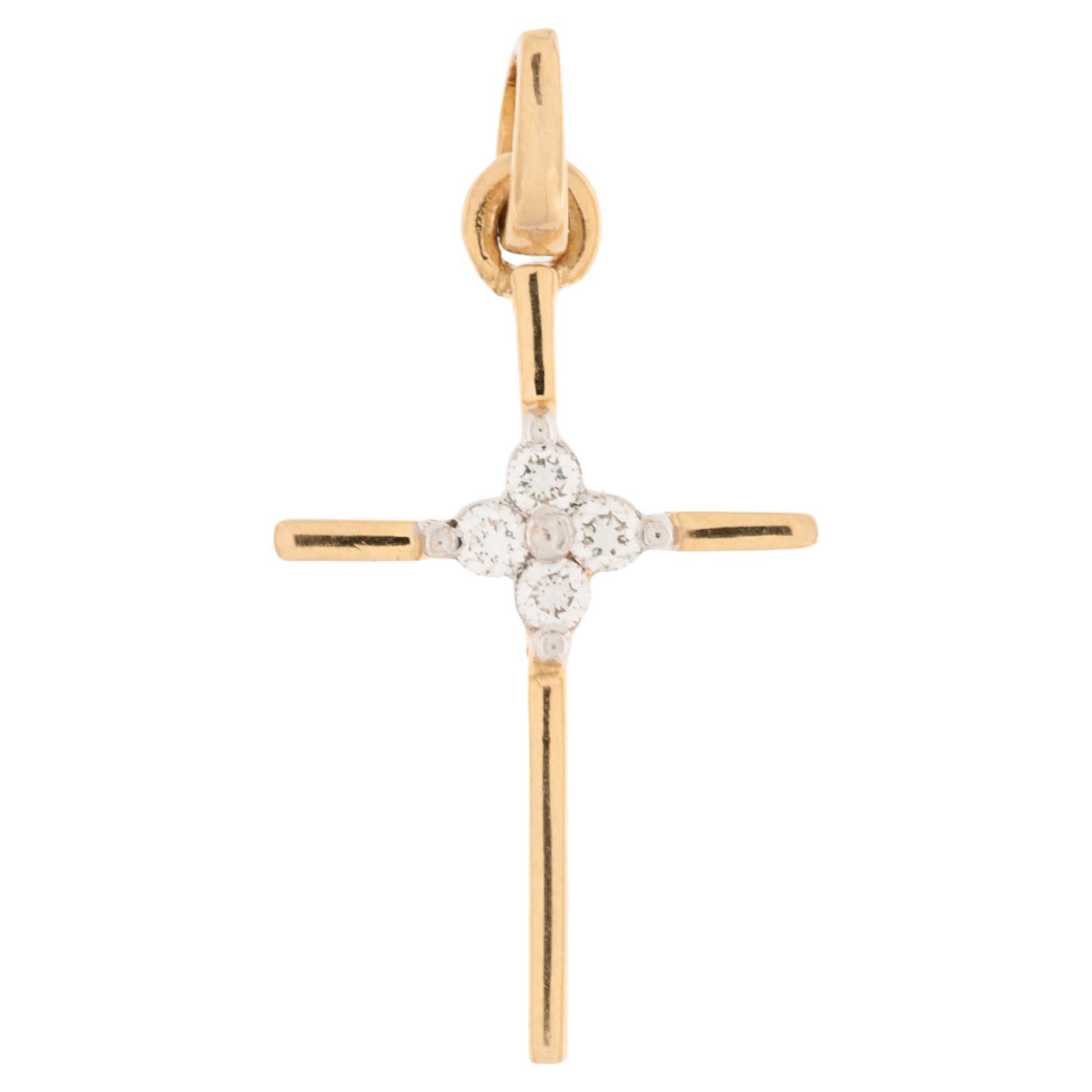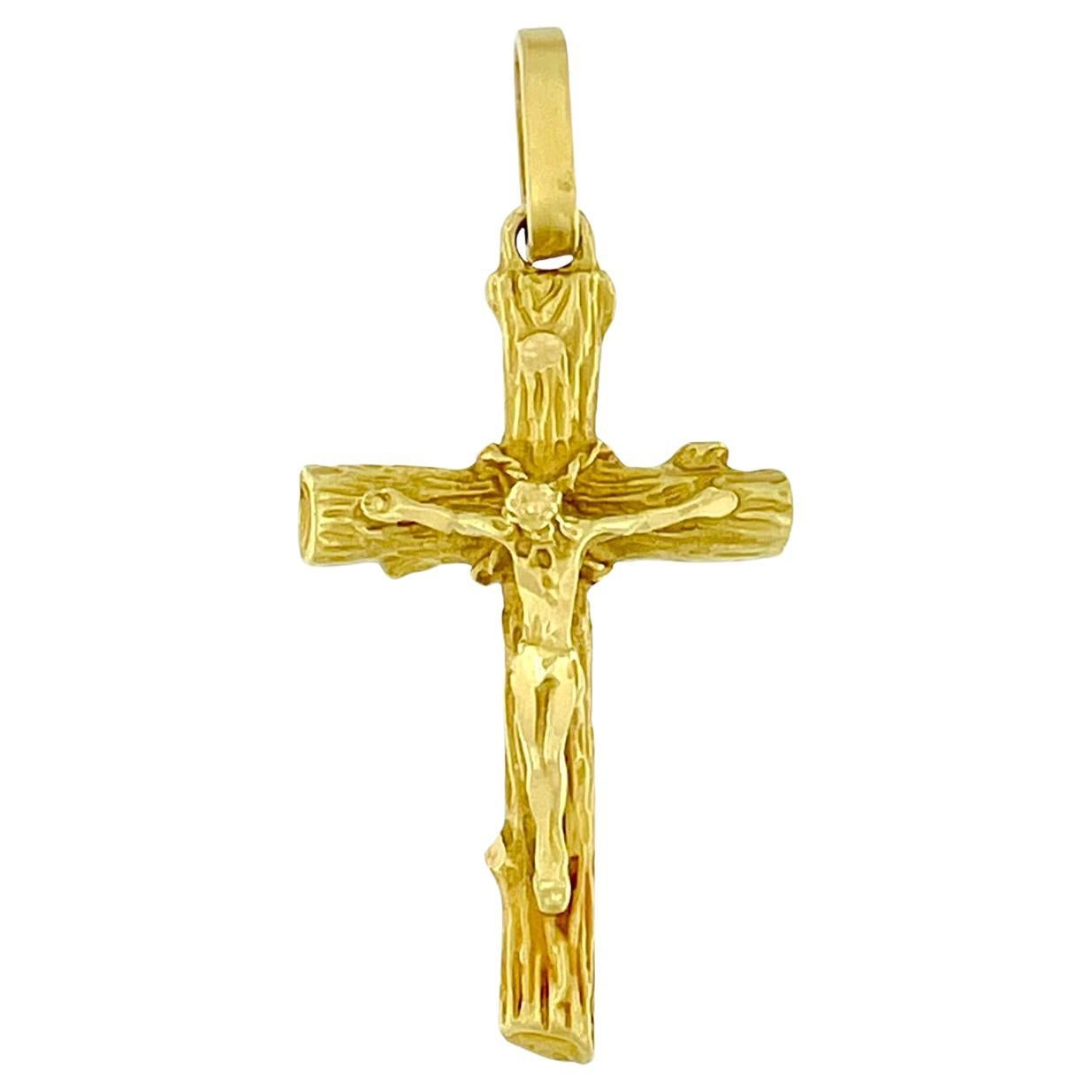Items Similar to Germano Nino D'Antonio 1970 Renaissance Revival Medallion In 18Kt Yellow Gold
Want more images or videos?
Request additional images or videos from the seller
1 of 9
Germano Nino D'Antonio 1970 Renaissance Revival Medallion In 18Kt Yellow Gold
About the Item
Medallion designed by Nino D'Antonio Germano.
Beautiful piece of jewelry art, created in Roma Italy by the jeweler sculptor Nino D'Antonio Germano. This fantastic medallion was crafted in the classical renaissance Revival style, in solid yellow gold of 18 karats, with textured and polished finishes. Made up with free forms shapes and fitted on top with a movable ring of 14mm to wear in a chain or necklace.
Weight: 14.70 Grams, (9.42 Dwt).
Measurements: 28 mm by 45 mm (1.10 x 1.77 Inches).
Hallmarks: Stamped with Italian marks; the maker's mark, the mark for the assay of the gold and signed, "GERMANO 18KT .750 ITALY *157ROMA".
Nino D'Antonio Germano
He was an Italian sculptor and jeweler. Was born into the Alfonsi jewelry family in the 1926. He lived above the family workshop in the via dei Giubbonari in Rome, as a child he learn the traditional method of making jewelry. His work included the traditional method of lost wax casting, which involve the destruction of the original wax sculpture. the plaster cast from each piece can be used only one time, resulting that each piece of jewelry are unique. Germano focused on classical themes as his inspiration, from the ancients Greeks, the Romans and the Italian renaissance. Germano was also a highly accomplished bronze sculptor, drawer and a painter. In all these disciplines, he looked back to the classical themes, following the tradition of the artist jewelers at that period. First typified by Benvenuto Cellini and Donatello in the 16th century. His crude sculptures have a reminiscence of the French sculptor Auguste Rodin. He produced works of extreme quality and individuality, elevating him to be considered among the finest artist-jewelers.
Literature: Nino D'Antonio Germano, Ars Maior, Roma 1974, Pp 103, 114-115 for similar examples illustrated. S. Brecker (translator), Nino D'Antonio Germano studio, catalog book, pp. 118-119.
Provenance: A private collection of artist-jewelry in Palm Beach, Florida.
Collateral: It is accompanied by a presentation jewelry box.
Condition: The overall condition of this medallion is excellent. Beside the little normal wear, there is no damage to the gold. All parts are secured in the settings. This piece has been carefully inspected to guarantee the condition and authenticity.
INVENTORY REF: P091023XIEN/.3533
- Creator:Nino D'Antonio Germano
- Metal:
- Weight:14.7 g
- Dimensions:Width: 1.7 in (43.18 mm)Length: 1.77 in (44.96 mm)
- Style:
- Place of Origin:
- Period:
- Date of Manufacture:1965
- Condition:Wear consistent with age and use. The overall condition of this medallion is excellent. Beside the little normal wear, there is no damage to the gold. All parts are secured in the settings. This piece has been carefully inspected to guarantee the condition and authenticity.
- Seller Location:Miami, FL
- Reference Number:
About the Seller
4.9
Recognized Seller
These prestigious sellers are industry leaders and represent the highest echelon for item quality and design.
Platinum Seller
These expertly vetted sellers are 1stDibs' most experienced sellers and are rated highest by our customers.
Established in 1995
1stDibs seller since 2022
424 sales on 1stDibs
Typical response time: <1 hour
- ShippingRetrieving quote...Ships From: Miami, FL
- Return PolicyA return for this item may be initiated within 1 day of delivery.
More From This SellerView All
- Byzantine Revival 1850 Enameled Polychrome Cross In Solid 18Kt Yellow GoldLocated in Miami, FLByzantine revival enameled Christian Cross Fabulous antique cross, created in Europe in the middle of the 19th century, circa 1850. This exceptional rare cross has been crafted with...Category
Antique 1830s Italian Byzantine Pendant Necklaces
MaterialsEnamel, Yellow Gold, 18k Gold, Gold
- Antonio Cavelti 1970 For Birks Geometric Sculptural Earrings In 18Kt Yellow GoldLocated in Miami, FLPair of geometric earrings designed by Antonio Cavelti for Birks. Fabulous pair of sculptural earrings, created in Canada by the artist and goldsmith Antonio Cavelti, back in the 1970 to be retailed at the Maison Birks jewelers. This pair has been crafted in solid yellow gold of 18 karats with high polished finish. Created with cubism patterns and fitted with posts (Removable) and comfortable French omega backs for fastening clips, Weight: 16.45 Grams, (10.54 Dwt). Measurements: 36 mm by 36 mm (1.41 x 1.41 Inches). Hallmarks Stamped with the maker's mark, the mark for the assay of the gold and signed, "BIRKS .750 18kt CAVELTI". Toni Cavelti, was a creative artist, craftsman, and jeweler based in Vancouver, British Columbia, on Canada. He has retired from jewelery, but continues to be a creative artist. He has said that he feels jewelry is more craft than art. However, the jewels we see from the Cavelti workshop are easy to see as art. Apprenticed in Switzerland, in 1954, a young Toni Cavelti arrived in his chosen new home of Vancouver, British Columbia. He found work in the jewelry business, and his designs and style promptly became an important part of Vancouver style and society. In the 1960s and 1970s...Category
Vintage 1970s Canadian Modernist Clip-on Earrings
MaterialsGold, 18k Gold, Yellow Gold
- Liuba Wolf 1970 Concretism Sculptural Pendant Necklace Chain In 18Kt Yellow GoldLocated in Miami, FLSculptural necklace designed by Liuba Wolf. Extremely rare sculptural necklace, created in Sao Paulo Brazil by the artist Liuba Wolf, back in the 1970. This fantastic piece is a one of a kind and has been crafted with concretism art patterns in solid rich yellow of of 18 karats with textured surfaces. The main pendant is completely chiseled with irregular hammered finishes and sharp edges It is fitted with a removable chain in suite, which is composed of twenty six geometric links of different lenght and a security hook lock. Weight: 108.52 Grams, (69.57 Dwt). Size: The lenght of the chain is 25 Inches, (63.5 Cm). Measurements: The main sculpture pendant is 55 mm by 71 mm by 10 mm (2.16 x 2.79 0.39 Inches). Hallmarks: Stamped with the designer artist name, the mark for the assay of the gold, the edition number and signed, "LIUBA .750 1/30 1/50". Edition: Brazil Sao Paulo 1/30 for the pendant and 1/50 for the geometric chain, the authorized edition was only of 30 and 50 pieces, respectively but the production was never completed and only the number 1 of each one was made. Both pieces are stamped with the edition numbers. Liuba Wolf She born as Liuba Boyadjieva in Sofia Bulgaria in 1923. She was raised in a privileged, cultivated milieu by a writer mother and industrialist father who (he also played the violin) instilled in her a taste for music. The artist received a humanistic education, studying Greek and Latin and mastering the piano. When her family moved to Geneva, she attended art school and developed a special interest in sculpture. Later, she studied in Zurich under Germaine Richier (1904-1958), a renowned artist of the Paris School. This contact with Germaine Richier had a strong impact on Liuba Boyadjieva’s education as a modern sculpture and left a deep imprint on her understanding of sculpture. In those years, in Zurich, she was also in contact with a group of important artists, like, among others, Marino Marini and Arthur Honnegger. At the end of the war, when Richier reopened her atelier in Paris, Liuba moved to the French capital and continued her studies with her teacher until 1949. Her social circle in France included Zadkine, Viera da Silva, Alberto Magnelli, among others. She traveled often throughout Europe and visited the most important museums. Liuba Boyadjieva came to Brazil, married the industrialist and collector Ernesto Wolf in 1958, and lived between São Paulo and Paris, keeping studios in both cities. She became a naturalized Brazilian citizen. She developed a personal way of working her sculptures and achieved full artistic maturity. In the 1960s and 1970s, Liuba Wolf exhibited her work in several cities around the world and achieved international recognition. In 2001, on the occasion of her exhibition at Achim Moeller Fine Art. Rizzoli (New York) published a book celebrating Wolf’s art and featuring Sam Hunter’s essay “Liuba: At the Edge of Abstraction.” Among the central features of Liuba Wolf’s work are her expressive power, the surface’s play between the smooth and the textured, and rusticity. Verticality is another key characteristic, as well as the gesturalism of the forms. Figurative early on in her career, Wolf’s works became abstracted starting in the 1950s, but there always remained an archaic memory that referred back to primitive archetypes. Some critics, like Sam Hunter, see in those shapes a reference to pre-Columbian realities. Another highlight is a degree of surrealism in Wolf’s abstraction, yet critics mostly underscore the fact that she situated her sculptures at the border between abstraction and figuration, as well as the force of imagination in the conception of the works. On more than one occasion Liuba Wolf said that her forms are born from the subconscious. For her, they are “bugs”, animals, but they can also be plants or roots. They could be totems, in a symbiosis between the animal and the plant worlds, according to another observer, artist Emmanoel Araújo. Liuba Wolf stated once in an interview that her work “finds inspiration in natural shapes.” The exhibition at the Lasar Segall...Category
Vintage 1960s Brazilian Modernist Pendant Necklaces
MaterialsGold, 18k Gold, Yellow Gold
- Bauhaus Germany 1970 Modernist Pendant Brooch in 18Kt Yellow Gold and SteelLocated in Miami, FLA modernist Bauhaus studio pendant-brooch. Interesting modernist vintage piece, created around the 1970'S in northern Europe, probably Germany, Austria or Switzerland. This art-pie...Category
Vintage 1970s German Modernist Brooches
Materials18k Gold, Yellow Gold, Steel
- Antonio Bernardo Sculptural Geometric Ring In Solid 18Kt Yellow GoldBy Antonio BernardoLocated in Miami, FLGeometric sculptural ring made in Brazil. designed by Antonio Bernardo. Exceptional geometric cocktail ring, created in Brazil with concretism artistic patterns. This ring is a one ...Category
20th Century Brazilian Modernist Cocktail Rings
MaterialsGold, 18k Gold, Yellow Gold
- Renaissance Revival 1880 Sword Jabot In 18Kt Gold With Demantoids And DiamondsLocated in Miami, FLRenaissance Revival sword jabot-brooch. An exceptional and very rare jabot type brooch, created in England during the Victorian era, back in the 1880. This piece is fantastic and has been crafted with renaissance revival patterns in the shape of a miniature sword with jewels, in solid yellow gold of 18 karats with accents in carved platinum. The sword is well proportionate and made with gorgeous details. It is completely decorated with twisted woven wires, engravings and chiseled designs. The sword sheath, the grip pommel and the rain-guard are embellished with a fantastic assortment of eleven natural earth mined gemstones; such white colorless diamonds and vivid green demantoids garnets. It is fitted with a sheath to slide the blade very tight, which is attached to a decorative security chain. This magnificent piece should be an important addition to any serious jewelry collection and will be a great conversation piece when you display it with your dress or on the lapel of your jacket. Demantoids Demantoid is the green gemstone variety of the mineral andradite, a member of the garnet group of minerals. Andradite is a calcium- and iron-rich garnet. Ferric iron is the cause of the green in the stone. Although garnets have been known since ancient times, the demantoid variety was not discovered until 1868 in Russia's western central Ural Mountains. The find was an alluvial deposit about 110 km from Ekaterinburg, north by northwest along the Bobrovka River, near the village of Elizavetinskoye. Miners were immediately stunned by the highly refractive nature of the gem material, which is atypical for garnet. They began comparing it to diamond and referred to it as "demantoid", from the old German Demant, meaning diamond. The reason is obvious, with its high brilliance and dispersion. However, as demantoid garnets are quite rare and found in so few locations, they can command quite high prices, especially if they have a particularly lovely horsetail inclusion. Most stones are less than one carat in size after cutting in polishing. Demantoid gems...Category
Antique 1880s English Renaissance Revival Brooches
MaterialsGarnet, White Diamond, Diamond, Gold, Platinum, Yellow Gold, 18k Gold
You May Also Like
- 18kt Yellow Gold Chain CrossLocated in Esch-Sur-Alzette, LUThis cross is particular and stands out from the others thanks to its shape. The design represents a small chain that forms a cross. This pendant is in excellent condition and shows ...Category
Late 20th Century Swiss Contemporary Pendant Necklaces
MaterialsYellow Gold
- 80s Vintage Spanish Cross in Yellow Gold 18ktLocated in Esch-Sur-Alzette, LU“Simplicity is the keynote of all true elegance.” said Coco Chanel. Simple and elegant, this cross is entirely made of 18kt yellow gold. The geometric line of this pendant is reminiscent of 80s...Category
Late 20th Century Spanish Modern Pendant Necklaces
Materials18k Gold, Yellow Gold
- Vintage 18kt Yellow Gold French CrossLocated in Esch-Sur-Alzette, LUThe Vintage 18kt Yellow Gold French Cross is a beautiful and classic piece of jewelry and a religious artifact. The term "vintage" typically refers to i...Category
20th Century French Artisan Pendant Necklaces
MaterialsDiamond, 18k Gold, Yellow Gold
- Vintage Italian 18kt Yellow Gold CrucifixLocated in Esch-Sur-Alzette, LUThis Vintage Italian Crucifix is a captivating piece of religious jewelry crafted from lustrous 18-karat yellow gold. The crucifix stands out with its unique and intricate relief wor...Category
Early 20th Century Italian Modern Pendant Necklaces
Materials18k Gold, Yellow Gold
- Diamond Solitaire 18kt Yellow Gold PendantLocated in Esch-Sur-Alzette, LUThe Diamond Solitaire 18kt Yellow Gold Pendant is a striking and sophisticated piece that embodies understated luxury. Crafted with precision ...Category
21st Century and Contemporary Luxembourgish Artisan Pendant Necklaces
MaterialsDiamond, 18k Gold, Yellow Gold
- Vintage 18kt Yellow Gold Spanish CrucifixLocated in Esch-Sur-Alzette, LUThe Vintage 18kt Yellow Gold Spanish Crucifix is a religious artifact that features a crucifix design and is made of 18-karat yellow gold. Crucifixes ...Category
20th Century Spanish Modern Pendant Necklaces
Materials18k Gold, Yellow Gold
Recently Viewed
View AllMore Ways To Browse
Male Cameo Pendant
35mm Diamond 20k Gold
Florence Coin Ring
Gold Bolero Necklace
Pasquale Bruni Amore Heart
Ezra Kassin
Vintage Adler Necklaces
Solid Rose Gold Chain
750 Cross Pendant
Victorian Black Jet Necklace
Jewish Star Gold Chain
18k Multigem Necklace
Turquoise Stone Necklace
Picasso Jewellery
Jb France
Ruby And Gold Necklace Earring
Jb 18k
Larimar Stone





